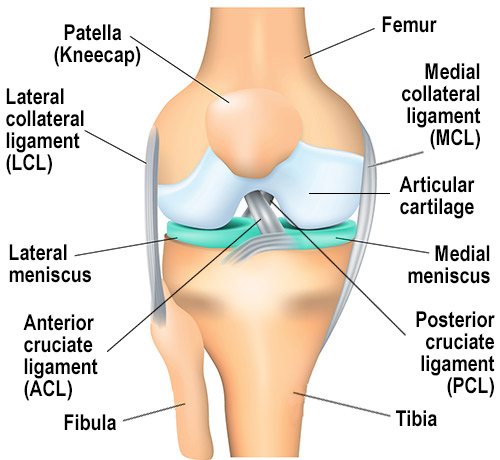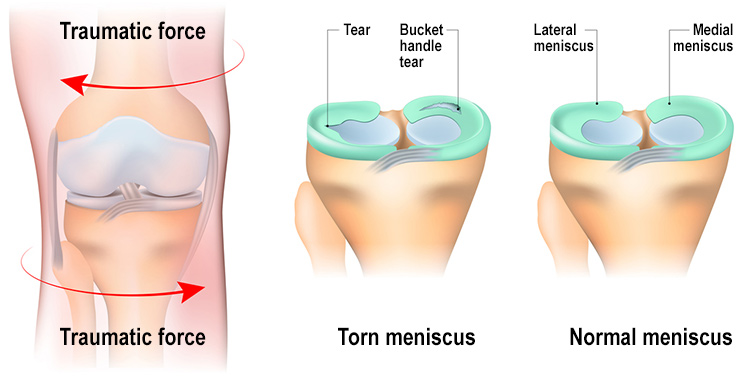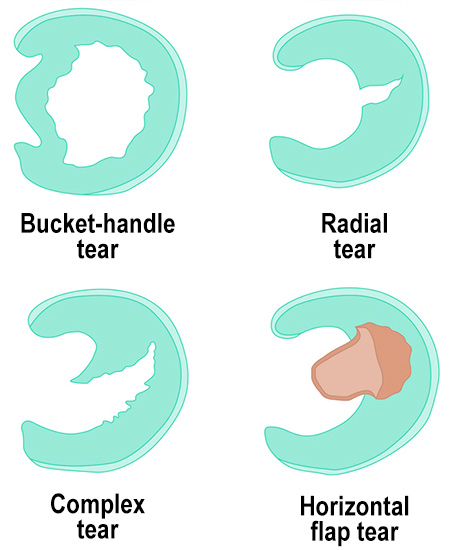Torn Meniscus

A healthy meniscus acts as a shock absorber, stabilizer, and provides a smooth surface for your knee to glide on. A tear in the meniscus causes pain and locking. Injuries to the meniscus are common, particularly among athletes.
What is the meniscus?
The meniscus is a structure in the knee joint that spans and cushions the space between the femur (thighbone) and the tibia (shinbone). There are two menisci in each knee – one on the inside (the medial meniscus) and one on the outside (the lateral meniscus).
Each is made of strong fibrocartilage and is shaped like a crescent or the letter “C.” Located at the periphery of the tibial surface in the knee, the menisci are contoured to optimize the contact between the femur and tibia to enhance stability and distribute stresses evenly across the joint.

Anatomy of the knee joint with the two menisci highlighted.
What does the meniscus do?
The shape and size of the meniscus allows it to serve several functions. When you stand up, your weight is borne evenly through your legs through your knees. The stress this weight places on the knees becomes even higher while walking, running, and jumping. The meniscus functions as a cushion to keep the bones of the knee joint from grinding against one other and causing damage. It also transmits the load of your weight evenly across the knee joint to stabilize it and assists with lubrication, and proprioception (spatial awareness). This load-sharing helps to prevent knee injuries and is extremely important to the function and health and joint stability of the knee.
If you injure your meniscus, it can change the way your knee functions. Over time, the alteration of s loading mechanics across the joint accelerates the progression of osteoarthritis. The most common type of meniscus injury is a meniscal tear.
What are the symptoms of a torn meniscus?
The key symptom of a meniscus tear is pain in the knee joint. A locking or catching sensation may also be felt in the knee leading to inflammation. There may also be a feeling of weakness in the leg and a sense of the knee buckling or “giving way.” This is because displaced, fragmented tissue from a torn meniscus and swelling in the knee can affect proprioception and the thigh muscles that support knee function.
Pain is usually felt in the knee above the meniscus while bearing weight on the affected knee and/or when twisting, turning, or pivoting on the knee. This may occur while getting in and out of a car. Walking up or down stairs may be particularly painful and may also cause increased swelling in the knee.
What does a torn meniscus look like on the outside?
A new traumatic injury to the meniscus will cause swelling of the knee. The knee will often be very warm to the touch. Due to the swelling, it may be hard to bend the knee. An older tear or a degenerative tear may not look as dramatically swollen.
What causes a meniscal tear?
The meniscus tears due to an acute injury (traumatic meniscal tear) or from being worn down over time (degenerative meniscal tear). Traumatic tears usually result from a forceful twisting of the knee. Degenerative tears usually occur in older people, as years of use can lead the meniscus to deteriorate.

Traumatic tears
A traumatic tear of the meniscus usually occurs when a competitive athlete or other highly active person quickly turns their body, pivoting on the knee while their foot is still planted on the ground. It is a common sports injury among football, basketball, and soccer players, but it can occur during any activity involving knee twisting. Less often, repetitive kneeling or rising from a squatting position while lifting can lead to a traumatic tear.
Degenerative tears (atraumatic)
Degenerative or atraumatic tears, usually seen in older people, are caused by biological degeneration and breakdown of the meniscal structure. People with degenerative tears may accelerate tears by twisting their knees. However, the tear pattern in a degenerative tear is different from that of a traumatic tear. This is important because the treatment for a degenerative tear is different from that of a traumatic tear.
What are the different types of meniscus tears?
Tears can occur in various locations within the menisci as well as in different patterns. Subtypes, which have specific characteristics and treatment options, include ramp lesions (also known as meniscocapsular separation), radial tears, horizontal tears, longitudinal tears, bucket tears , peripheral tears and complex tears.
Meniscus tear types and patterns
- Ramp lesion – a tear in the back of the inner part of the meniscus (posterior portion of the medial meniscus). Ramp lesions are located in the part of the meniscus that has better blood flow (called the red zone). Smaller ramp lesions may heal without surgery because of the local blood supply.
- Intrasubstance (or horizontal) tear – associated with non-traumatic injuries (often called “degenerative”). These are more common in patients over 40. They don't always progress. They can sometimes be observed and treated conservatively.
- Radial meniscus tear – a tear from the inner portion of the meniscus towards the outer portion in the area of the meniscus that doesn't get much blood flow (white zone).
- Longitudinal meniscus tear – a tear that runs lengthwise along the meniscus. Depending on the location of a longitudinal tear, it may be able to heal.
- Bucket-handle tear – a type of longitudinal tear that can be painful because it can flip (like a bucket handle) and become painful as it gets pinched when the knee bends.
- Complex tear – a combination of a vertical and radial tear.
- Flap tear – a form of intrasubstance tear that, like the bucket-handle tear, can become flipped up and painful at times.

How is a torn meniscus diagnosed?
Your doctor will ask about your symptoms, your injury and conduct a physical examination. Radiological imaging studies will be ordered to confirm a diagnosis. X-rays will help rule out fractures or other bone injuries as the cause of pain and high-resolution magnetic resonance imaging (MRI) studies will help reveal the type and location of the tear.
What is the McMurray test for a meniscus tear?
This is a standard part of the physical exam that can help determine whether there is a tear in the rear portion of either the medial or lateral meniscus. With the patient lying on their back and the knee fully bent, the doctor holds the knee with one hand and the foot with the other, then rotates the knee outward while straightening it. This may be repeated at different angles. Pain accompanied by a snapping, clicking or popping sound suggests a tear is present in the rear of the medial meniscus. The test is then repeated but with inward rotating. A snapping, clicking or clunking sound during this movement suggests a tear in the rear of the lateral meniscus.
What type of doctor treats meniscus tears?
If you suspect a meniscus tear, it is important to be evaluated by a physiatrist, a sports medicine doctor, or an orthopedic surgeon who specializes in sports medicine. (Find a doctor at HSS who treats meniscal tears.)
Can a meniscus tear heal on its own?
The meniscus has a limited blood supply and, therefore, it has limited ability to heal on its own. Only the outer one-third of the meniscus contains blood vessels required for healing. This is known as the “red zone.” The inner two-thirds of the meniscus is avascular (meaning there is no blood supply) and is also known as the “white zone.” Most meniscus tears that affect the white zone cannot heal on their own.
Will walking on a torn meniscus make it worse?
Simple walking and other activities that do not require twisting, pivoting, rapid change of direction, etc., are generally well-tolerated after a meniscus tear. Tears can progress over time, but the rate of progression is generally gradual and highly variable. Pain is the guide. If a tear is being made worse, there will generally be associated symptoms of increased pain.
What is the treatment for a torn meniscus?
Nonsurgical treatments, such as anti-inflammatory medications and rehabilitation with a physical therapist may help some people with a torn meniscus. Other patients will need surgery, which entails either trimming or repairing the meniscus. Treatments may also depend on whether the tear is traumatic or degenerative.
Treatment for a meniscus tear without surgery
A non-operative physical therapy treatment program will often focus first on reducing pain and maintaining the full motion of the knee. Oral nonsteroidal anti-inflammatory medications (such as ibuprofen) may also be prescribed. After the initial injury pain has decreased and the knee motion is restored, treatment may move to muscle strengthening. Plasma-rich platelet (PRP) injections may be beneficial to some patients.
Degenerative tears without any separated meniscal fragments may cause mechanical symptoms in the knee. These can often be treated without surgery through conservative treatment.
What is recovery time for a meniscus tear not requiring surgery?
It depends on the location of the tear. In an area with better blood flow, it may take 4 to 6 weeks to heal. Adequate rest is a key factor for meniscus healing, and it also mitigates further injury. After the initial recovery period, physical therapy may be necessary to build up supporting knee muscles that have atrophied. If surgery is needed, there may be an additional six weeks of recovery followed by physical therapy.
Surgical treatment for meniscal tears
Fragmented degenerative tears and most acute, traumatic tears will need meniscus surgery. The indications for surgery vary but include:
- the location and size of the injury.
- whether it is traumatic versus degenerative.
- the patient’s age and level of activity.
- the amount of pain caused by the tear.
- the presence of mechanical symptoms. Surgery is most likely to help with large, traumatic tears that cause clicking, catching, or locking.
Traditional meniscus surgery involves removing part of the meniscus, but there are more recent efforts to save and repair the meniscus. However, this is difficult, and results are mixed. HSS physicians, biologists, and engineers are investigating ways to improve repair outcomes. Some of the research is focused on the incorporation of orthobiologics – biological treatments that promote musculoskeletal tissue growth (also known as biological augmentation).
What happens if you leave a torn meniscus untreated?
Untreated tears can progress and become worse over time. Progressive meniscus loss can increase the risk that a person will develop degenerative knee arthritis. It is important to get a diagnosis and seek treatment early. Learn more from the content below or find a doctor at HSS who can diagnose and treat a torn meniscus.
Articles on treatments for a torn meniscus
Articles on related knee conditions and issues
Torn Meniscus Success Stories
Updated: 6/12/2024
Reviewed and updated by Alice Chen, MD; Shevaun Mackie Doyle, MD; Peter D. Fabricant, MD, MPH; and Daniel W. Green, MD, MS, FAAP, FACS
References
- Bansal S, Floyd ER, A Kowalski M, Aikman E, Elrod P, Burkey K, Chahla J, LaPrade RF, Maher SA, Robinson JL, Patel JM. Meniscal repair: The current state and recent advances in augmentation. J Orthop Res. 2021 Jul;39(7):1368-1382. doi: 10.1002/jor.25021. Epub 2021 Mar 19. PMID: 33751642; PMCID: PMC8249336.
- Fox AJ, Wanivenhaus F, Burge AJ, Warren RF, Rodeo SA. The human meniscus: a review of anatomy, function, injury, and advances in treatment. Clin Anat. 2015 Mar;28(2):269-87. doi: 10.1002/ca.22456. Epub 2014 Aug 14. PMID: 25125315.
- Hutchinson ID, Rodeo SA. The Current Role of Biologics for Meniscus Injury and Treatment. Curr Rev Musculoskelet Med. 2022 Dec;15(6):456-464. doi: 10.1007/s12178-022-09778-z. Epub 2022 Jul 26. PMID: 35881326; PMCID: PMC9789233.
- Kunze KN, Wright-Chisem J, Polce EM, DePhillipo NN, LaPrade RF, Chahla J. Risk Factors for Ramp Lesions of the Medial Meniscus: A Systematic Review and Meta-analysis. Am J Sports Med. 2021 Nov;49(13):3749-3757. doi: 10.1177/0363546520986817. Epub 2021 Feb 10. PMID: 33565883.
- MacFarlane LA, Yang H, Collins JE, Brophy RH, Cole BJ, Spindler KP, Guermazi A, Jones MH, Mandl LA, Martin S, Marx RG, Levy BA, Stuart M, Safran-Norton C, Wright J, Wright RW, Losina E, Katz JN. Association Between Baseline Meniscal Symptoms and Outcomes of Operative and Nonoperative Treatment of Meniscal Tear in Patients With Osteoarthritis. Arthritis Care Res (Hoboken). 2022 Aug;74(8):1384-1390. doi: 10.1002/acr.24588. Epub 2022 May 6. PMID: 33650303; PMCID: PMC8408275.
- Maher SA, Rodeo SA, Warren RF. The Meniscus. J Am Acad Orthop Surg. 2017 Jan;25(1):e18-e19. doi: 10.5435/JAAOS-D-16-00689. PMID: 28002217.
- Rodeo SA, Monibi F, Dehghani B, Maher S. Biological and Mechanical Predictors of Meniscus Function: Basic Science to Clinical Translation. J Orthop Res. 2020 May;38(5):937-945. doi: 10.1002/jor.24552. Epub 2019 Dec 16. PMID: 31799733.

